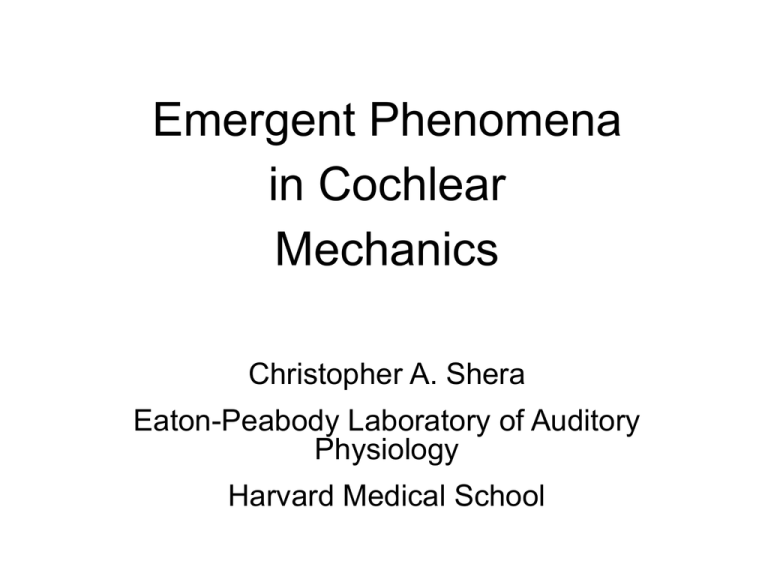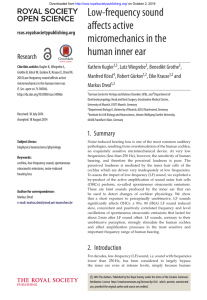Emergent Phenomena in Cochlear Mechanics Christopher A. Shera
advertisement

Emergent Phenomena in Cochlear Mechanics Christopher A. Shera Eaton-Peabody Laboratory of Auditory Physiology Harvard Medical School What is the Biophysical Origin of the Cochlear Amplifier? Or active hair-bundle motility? Is it somatic electromotility? (Hudspeth 1997) “The rapid conformational change associated with channels closing together tightens tip links and moves the hair bundle by several nanometers. It has been suggested that this mechanism, if timed appropriately to different stimulus frequencies for each hair cell, could amplify the vibration of the cochlea’s basilar membrane (a process termed the ‘cochlear amplifier’). If If so, so, the the TRPA1 TRPA1 protein protein could could be be at at once once the hair-cell transduction channel, the gating spring, and the cochlear amplifier.” amplifier.” The Debate is Misleadingly Framed The cochlear amplifier is not EITHER somatic motility OR hair-bundle motility. The cochlear amplifier is not BOTH. The cochlear amplifier is NEITHER. Insights from Cochlear Modeling Inverse method (e.g., Zweig, de Boer) Determines functional properties of the organ of Corti from measurements of BM motion The Impedance of the Organ of Corti ZBM(x,f )= Psv - Psv VBM = ZPassive + ZActive Psv Pst Cochlear cross section at location x What are the relative contributions of the passive and active components? VBM BM-Admittance Frequency Responses Passive Active Total (passive component component & active) The Impedance of the Organ of Corti ZBM(x,f )= ZPassive + ZActive Cochlear cross section at location x Effects of Fluid Coupling Between the Oscillators The Impedance of the Organ of Corti ZBM(x,f )= ZPassive + ZActive Cochlear cross section at location x Effects of Scalae Height (Nature of Fluid Coupling “The rapid conformational change asssociated with channels closing together tightens tip links and moves the hair bundle by several nanometers. It has been suggested that this mechanism, if timed appropriately to different stimulus frequencies for each hair cell, could amplify the vibration of the cochlea’s basilar membrane (a process termed the ‘cochlear amplifier’). If so, the TRPA1 protein could be at once the hair-cell transduction channel, the gating spring, and the cochlear amplifier.” a^force-producing element of Principle of Emergence In a structured system, new properties emerge at higher levels of integration which could not have been predicted from a knowledge of the lower-level components. Ernst Mayr Spontaneous Otoacoustic Emissions (SOAEs) (Allen et al. 1995) Gold’s (1948) Local-Oscillator Model “…if the feedback ever exceeded the losses, then a resonant element [in the organ of Corti] would become self-oscillatory, and oscillations would build up [to] a level where linearity was not preserved.” “In spite of [the] self-regulating mechanism we might expect that occasional disturbances would bring an element into the region of self-oscillation, when it is normally so close to this condition. If this occurred, then we should hear a clear note which would persist until the adjusting mechanism has regained control, or until the nervous sensitivity has decreased sufficiently.” Spontaneous Hair-Bundle Oscillations (Martin et al. 2001, 2003) Models for Hair-Bundle Oscillators Oscillation/SOAE frequencies are determined by cellular properties such as • Hair-bundle stiffness and geometry • Gating compliance • Adaptation and/or transduction kinetics • Ca2+ equilibration kinetics (Hudspeth 1997) SOAEs Used to Argue Against Somatic Motility as the “Active Process” in Mammalian Hearing • The motor element of the cochlear amplifier is the source of SOAEs • Unprovoked mechanical oscillations of the motor element underlie the production of • SOAEs Although hair bundles can oscillate spontaneously, no spontaneous OHC contractions have ever been observed The hair bundle is both the source of SOAEs and the motor element of the cochlear amplifier Gold’s Local-Oscillator Model Gets the Chain of Causality Exactly Backwards The ear does not produce SOAEs because hair cells oscillate spontaneously. Rather, hair cells oscillate spontaneously (in vivo) because the ear produces SOAEs. Kemp’s (1979) Global Standing-Wave Model SOAEs are continuously self-evoking stimulusfrequency otoacoustic emissions (SFOAEs) • initiated either by sounds from the environment or by physiological noise Spacetime Diagram Illustrating SFOAE Generation Interference Patterns in Ear-Canal Pressure Spacetime SpacetimeDiagram DiagramIllustrating IllustratingStanding SFOAE Generation Waves Effective Reflection Coefficients For ingoing-waves at stapes: For outgoing-waves at stapes: Human SFOAE Amplitude and Phase Spontaneous Otoacoustic Emissions (Allen et al. 1995) Human SFOAE Amplitude and Phase Quantifying the Model Predictions 9 ears in 9 subjects (Data from Shera & Guinan 2003 and Dreisbach et al. Human SOAE Spacings 556 SOAE pairs 73 ears 47 subjects (Data from Talmadge et al. 1993 and Burns et al. 1992) Variability of SOAE Spacings Summary of Results The global standing-wave model correctly predicts: • Multiple SOAEs with a characteristic minimum frequency spacing • The mean value of this spacing • Its standard deviation • Its power-law dependence on frequency • The magnitude, sign, and frequency dependence of SOAE frequency shifts induced by modulations in middle-ear stiffness Predictions arise naturally in the standing-wave framework but require ad-hoc adjustment of local-oscillator models. Local-Oscillator vs Global Standing-Wave SOAEs Local-Oscillator Global Standing-Wave Autonomous oscillators are cells or subcellular structures Autonomous oscillator is the cochlea as a whole Macromechanical structures and processes play no fundamental role: They simply provide a conduit for energy to escape from the cochlea Macromechanical structures and processes determine SOAE characteristics (e.g., SOAEs would not occur if Rstapes=0) SOAE frequencies are set by local properties of hair cells (e.g., hairbundle geometry, transduction kinetics, etc) SOAE frequencies are set by global properties (e.g., round-trip travelingwave phase shifts, middle-ear impedance, etc) The Cochlea is Acting as a Biological Laser Implications for the Cellular Basis of the Cochlear Amplifier Hudspeth and colleagues have repeatedly invoked Gold’s local-oscillator model to argue that OHC somatic motility is unlikely to constitute the “active process” in mammalian hearing (e.g., Martin & Hudspeth 1999, 2001; Martin et al. 2001, 2003; Duke 2002; Jülicher et al 2003). • Based on the apparent absence of spontaneous OHC contractions But Hudspeth’s argument that “unprovoked mechanical oscillations of some constituent of the inner ear must underlie the production of spontaneous otoacoustic emissions” is based on a logical fallacy. The Principle of Emergence In a structured system, new properties emerge at higher levels of integration which could not have been predicted from a knowledge of the lower-level components. Ernst Mayr The local-oscillator model gets the causality exactly backwards… SOAEs arise through the collective action of the entire cochlea. Spontaneous emission of sound from the ear does not require the autonomous mechanical oscillation of its cellular constituents. Characteristics of Emergent Phenomena Emergence occurs when a relatively small number of copies of relatively simple components are coupled together in relatively simple ways. The whole is more than the sum of its parts. Since the interactions are usually nonlinear, the collective behavior cannot be obtained by summing the behaviors of the isolated parts. The whole obeys different laws than the parts. Its behavior can be described by “macrolaws” without recourse to the detailed microlaws that govern the behavior of the components. The parts acquire new properties by virtue of their embedding in the whole. Context and coupling are crucial. The OHC Membrane Time-Constant Problem Conjecture: The problem is artificial because the solution is “emergent.” When embedded in situ, OHCs have an effective response bandwidth much greater than they do in isolation. Basic idea proposed long ago by modelers (e.g., Mountain & Hubbard 1994); for latest experimental evidence, see Scherer & Gummer, 2004. The Crucial Role of Mathematical Modeling in the Study of Hearing


